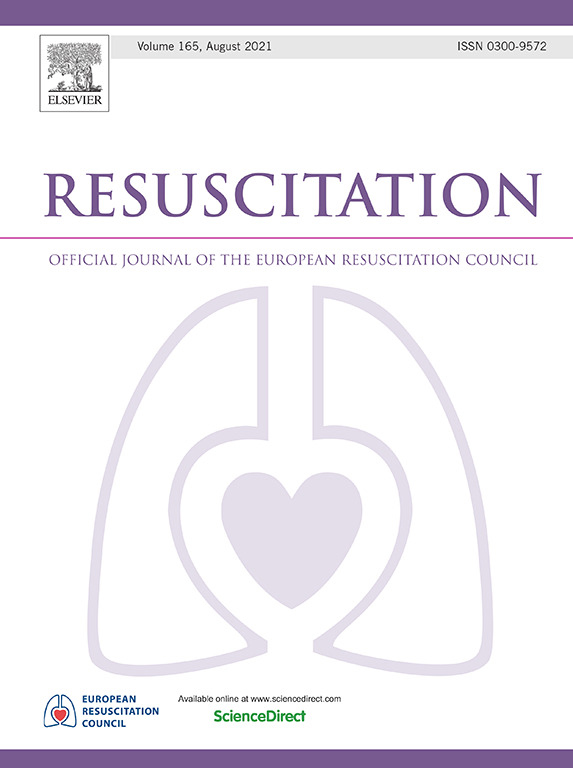低体温心脏骤停患者体外生命支持的效果:重新审视 ELSO 指南。
IF 6.5
1区 医学
Q1 CRITICAL CARE MEDICINE
引用次数: 0
摘要
研究目的:低体温型心脏骤停(HCA)患者不良预后的预测因素与正常体温型院外心脏骤停(OHCA)患者不同。本研究旨在评估根据体外生命支持组织(ELSO)制定的指南可能不符合条件的 HCA 患者使用体外生命支持(ECLS)的结果:一项回顾性多中心研究纳入了127例HCA患者,将其分为两组:符合ELSO体外生命支持组织资格标准的患者,以及至少符合以下一项ELSO排除标准的患者:年龄超过70岁、未经目击的心脏骤停或心跳停止:在 62 名符合 ELSO 标准的患者中,有 38 人(61%)存活到出院,其中 34 人(89%)获得了良好的神经功能预后。在不符合ELSO标准但接受了ECLS治疗的65名患者中,有24人(37%)存活到出院,其中20人(83%)的神经系统状况良好。在不符合一项或两项 ELSO 标准的患者中,存活率分别为 47 例中的 18 例(38%)和 16 例中的 6 例(38%),两组中均有 83% 的存活者获得了良好的神经功能预后。未能满足所有三个ELSO标准的两名患者未能存活:结论:对低体温性心脏骤停患者进行 ECLS 复温的资格审查不应严格依据正常体温性心脏骤停的指南,因为这可能导致无法为预后良好、神经系统状况良好的存活患者启动可能挽救生命的治疗。本文章由计算机程序翻译,如有差异,请以英文原文为准。
Outcomes of extracorporeal life support in hypothermic cardiac arrest: Revisiting ELSO guidelines
Aim of the study
Predictive factors for poor outcomes in hypothermic cardiac arrest (HCA) differ from those in normothermic out-of-hospital cardiac arrest (OHCA). This study aimed to evaluate the outcomes of extracorporeal life support (ECLS) in HCA patients who may not be considered eligible based on the guidelines set by the Extracorporeal Life Support Organization (ELSO).
Methods
A retrospective multicentre study included 127 HCA patients, divided into two groups: those meeting the ELSO eligibility criteria for ECLS, and those with at least one of the following ELSO exclusion criteria: age over 70 years, unwitnessed cardiac arrest, or asystole.
Results
Among the 62 patients who met the ELSO criteria, 38 (61 %) survived to hospital discharge, with 34 (89 %) achieving a favourable neurological outcomes. Of the 65 patients who received ECLS despite not meeting ELSO criteria, 24 (37 %) survived to discharge, with 20 (83 %) demonstrating a favourable neurological outcomes. In patients not meeting one or two ELSO criteria, survival rates were 18 of 47 (38 %) and 6 of 16 (38 %) respectively, with 83 % of survivors in both groups achieving favourable neurological outcomes. The two patients who failed to meet all three ELSO criteria did not survive.
Conclusion
Qualification of patients with hypothermic cardiac arrest for ECLS rewarming should not be strictly based on guidelines for normothermic cardiac arrest, as this may result in not initiating potentially life-saving treatment for patients who could have favourable prognoses for survival with good neurological outcomes.
求助全文
通过发布文献求助,成功后即可免费获取论文全文。
去求助
来源期刊

Resuscitation
医学-急救医学
CiteScore
12.00
自引率
18.50%
发文量
556
审稿时长
21 days
期刊介绍:
Resuscitation is a monthly international and interdisciplinary medical journal. The papers published deal with the aetiology, pathophysiology and prevention of cardiac arrest, resuscitation training, clinical resuscitation, and experimental resuscitation research, although papers relating to animal studies will be published only if they are of exceptional interest and related directly to clinical cardiopulmonary resuscitation. Papers relating to trauma are published occasionally but the majority of these concern traumatic cardiac arrest.
 求助内容:
求助内容: 应助结果提醒方式:
应助结果提醒方式:


